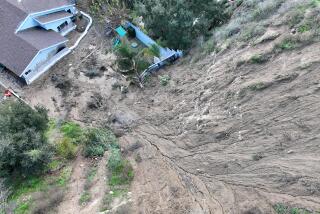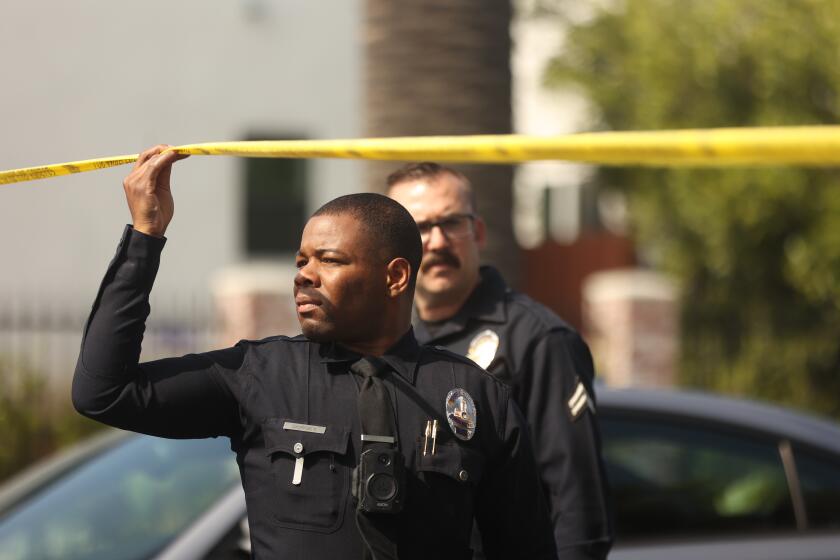We’re Drenched, but History Has Far Worse Tales
- Share via
This rain season is shaping up to be the wettest on record. It has caused numerous mudslides, traffic jams and flooded streets. Here’s a look at how Southern California has fared with heavy rains and floods in the past.
The Rainmaker
For the record:
12:00 a.m. March 12, 2005 For The Record
Los Angeles Times Saturday March 12, 2005 Home Edition Main News Part A Page 2 National Desk 0 inches; 30 words Type of Material: Correction
Rainmaker -- The Surroundings column in the Feb. 24 California section spelled the last name of Charles Mallory Hatfield, who had promised to bring rain to Southern California, as Hartfield.
A starchy Quaker sewing machine salesman named Charles Mallory Hartfield, who billed himself as a Moisture Accelerator, or Rainmaker, had been hired to make rain in almost every parched desert town in Southern California.
Using secret chemicals -- a formula he never revealed -- he was paid thousands of dollars to “precipitate moisture.” But it was the downpour that he took credit for in San Diego in 1916 -- 11.4 inches of rain that killed 20 people in floods and precipitated $3.5 million in lawsuits -- that drowned his rainmaking career in more than 20 years of ridicule and litigation.
His small-town career of big claims was captured in a Broadway play that became the 1956 movie “The Rainmaker,” starring Burt Lancaster.
St. Francis Dam Collapse
About midnight on March 12, 1928, the St. Francis Dam’s 200-foot-high concrete wall crumpled, sending 12 billion gallons of water down San Francisquito Canyon north of Saugus, killing at least 450 people.
At the time, engineer William Mulholland’s design was blamed, but a 15-year study released in 1992 concluded that the dam collapsed because its eastern edge sat on an ancient landslide. Given the state of geological knowledge at the time, Mulholland was unaware of the fatal flaw.
New Year’s Eve Tragedy
Twelve inches of rain fell in 48 hours, culminating with a flash flood in the Verdugo Hills on New Year’s Eve 1933. As streets in the La Crescenta Valley filled with debris, rocks and wrecked cars, people flocked to the safety of the American Legion clubhouse in La Crescenta. New Year’s revelers were there too. Around midnight, an avalanche of boulders and mud thundered into the hall, sweeping away the building and killing a dozen people. Nearly 40 others were killed in and around the area.
The Great 1938 Floods
The relentless five-day spate of rainstorms that began Feb. 27 turned the California plains into an inland sea. The deluge collapsed bridges, buckled highways, overwhelmed rivers and dams and sent an airliner with nine aboard slamming into a mountain.
The flood killed more than 100 people and left thousands homeless and scores missing, the toll scattered among several counties. It was Southern California’s deadliest natural flood of the 20th century.
In September, after a four-day tropical storm with gales reaching 65 mph had subsided, Southern California’s tragic coastal storm left 30 dead and dozens missing. The fishing boat Spray capsized near Point Mugu, carrying 26 crew members to their deaths. Many piers and wharves along the coastline, including those in Newport Beach and Balboa, were destroyed.
Muddy Hollywood Hills
Three months after the Bel-Air/Brentwood fires of 1962, which Life magazine called “A Tragedy Trimmed in Mink,” twin storms loosed tons of mud on houses, tossed cars down hillside streets and shoved mud hubcap-deep into Hollywood Boulevard. There were 21 deaths related to the storms.
A Battered Marina
Twin Southland storms in 1969, which began Jan. 18 and ended Feb. 25, forced the evacuation of an estimated 6,000 people in seven counties, virtually wiped out the Ventura marina and caused more than 90 deaths.
Piers Splintered
Huge waves, rolling on top of record high tides, savaged the California coast in the 1982-83 rain season. They inflicted severe damage to 12 piers, including those in Santa Monica, Seal Beach and Huntington Beach. Oil rigs were swallowed whole, and Santa Barbara evacuated the city’s harbor and low-lying neighborhoods.
In Malibu, three storm-battered homes, abandoned by their occupants, finally slid into the sea.
A rare tornado blasted through South-Central Los Angeles, destroying or damaging 100 homes and businesses before jumping a freeway and ripping into the Convention Center, tearing away part of the huge structure’s roof.
A second twister slammed into a Santa Ana mobile home park later in the day, causing no injuries but overturning one home and damaging 20 others. Dozens of lives were lost throughout the state.
More to Read
Sign up for Essential California
The most important California stories and recommendations in your inbox every morning.
You may occasionally receive promotional content from the Los Angeles Times.













